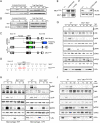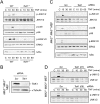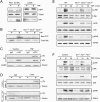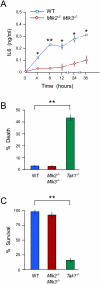TNF-stimulated MAP kinase activation mediated by a Rho family GTPase signaling pathway
- PMID: 21979919
- PMCID: PMC3197205
- DOI: 10.1101/gad.17224711
TNF-stimulated MAP kinase activation mediated by a Rho family GTPase signaling pathway
Abstract
The biological response to tumor necrosis factor (TNF) involves activation of MAP kinases. Here we report a mechanism of MAP kinase activation by TNF that is mediated by the Rho GTPase family members Rac/Cdc42. This signaling pathway requires Src-dependent activation of the guanosine nucleotide exchange factor Vav, activation of Rac/Cdc42, and the engagement of the Rac/Cdc42 interaction site (CRIB motif) on mixed-lineage protein kinases (MLKs). We show that this pathway is essential for full MAP kinase activation during the response to TNF. Moreover, this MLK pathway contributes to inflammation in vivo.
Figures







Similar articles
-
The MLK family mediates c-Jun N-terminal kinase activation in neuronal apoptosis.Mol Cell Biol. 2001 Jul;21(14):4713-24. doi: 10.1128/MCB.21.14.4713-4724.2001. Mol Cell Biol. 2001. PMID: 11416147 Free PMC article.
-
Activation of the small GTPase Cdc42 by the inflammatory cytokines TNF(alpha) and IL-1, and by the Epstein-Barr virus transforming protein LMP1.J Cell Sci. 1999 Sep;112 ( Pt 17):2983-92. doi: 10.1242/jcs.112.17.2983. J Cell Sci. 1999. PMID: 10444392
-
An essential role for Rac/Cdc42 GTPases in cerebellar granule neuron survival.J Biol Chem. 2001 Oct 19;276(42):39123-31. doi: 10.1074/jbc.M103959200. Epub 2001 Aug 16. J Biol Chem. 2001. PMID: 11509562
-
Vav transformation requires activation of multiple GTPases and regulation of gene expression.Mol Cancer Res. 2004 Dec;2(12):702-11. Mol Cancer Res. 2004. PMID: 15634759
-
Regulation of phosphorylation pathways by p21 GTPases. The p21 Ras-related Rho subfamily and its role in phosphorylation signalling pathways.Eur J Biochem. 1996 Dec 1;242(2):171-85. doi: 10.1111/j.1432-1033.1996.0171r.x. Eur J Biochem. 1996. PMID: 8973630 Review.
Cited by
-
β-Catenin-dependent lysosomal targeting of internalized tumor necrosis factor-α suppresses caspase-8 activation in apoptosis-resistant colon cancer cells.Mol Biol Cell. 2013 Feb;24(4):465-73. doi: 10.1091/mbc.E12-09-0662. Epub 2012 Dec 21. Mol Biol Cell. 2013. PMID: 23264463 Free PMC article.
-
MLK3 regulates bone development downstream of the faciogenital dysplasia protein FGD1 in mice.J Clin Invest. 2011 Nov;121(11):4383-92. doi: 10.1172/JCI59041. Epub 2011 Oct 3. J Clin Invest. 2011. PMID: 21965325 Free PMC article.
-
TNF-α can promote membrane invasion by activating the MAPK/MMP9 signaling pathway through autocrine in bone-invasive pituitary adenoma.CNS Neurosci Ther. 2024 May;30(5):e14749. doi: 10.1111/cns.14749. CNS Neurosci Ther. 2024. PMID: 38739004 Free PMC article.
-
TGFβ responsive tyrosine phosphatase promotes rheumatoid synovial fibroblast invasiveness.Ann Rheum Dis. 2016 Jan;75(1):295-302. doi: 10.1136/annrheumdis-2014-205790. Epub 2014 Nov 6. Ann Rheum Dis. 2016. PMID: 25378349 Free PMC article.
-
Domain specificity of MAP3K family members, MLK and Tak1, for JNK signaling in Drosophila.Genetics. 2014 Jun;197(2):497-513. doi: 10.1534/genetics.113.160937. Epub 2014 Jan 15. Genetics. 2014. PMID: 24429281 Free PMC article.
References
-
- Abe K, Rossman KL, Liu B, Ritola KD, Chiang D, Campbell SL, Burridge K, Der CJ 2000. Vav2 is an activator of Cdc42, Rac1, and RhoA. J Biol Chem 275: 10141–10149 - PubMed
-
- Bock BC, Vacratsis PO, Qamirani E, Gallo KA 2000. Cdc42-induced activation of the mixed-lineage kinase SPRK in vivo. Requirement of the Cdc42/Rac interactive binding motif and changes in phosphorylation. J Biol Chem 275: 14231–14241 - PubMed
-
- Chadee DN, Kyriakis JM 2004. MLK3 is required for mitogen activation of B-Raf, ERK and cell proliferation. Nat Cell Biol 6: 770–776 - PubMed
Publication types
MeSH terms
Substances
Grants and funding
LinkOut - more resources
Full Text Sources
Molecular Biology Databases
Miscellaneous
